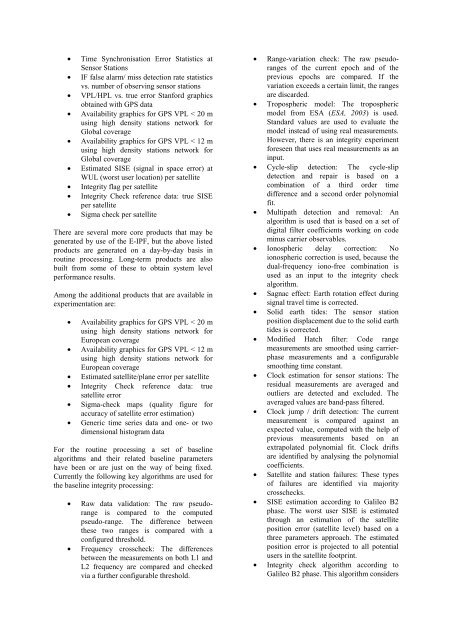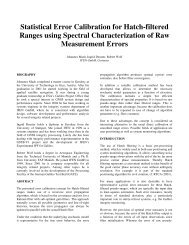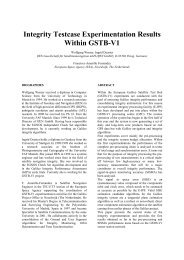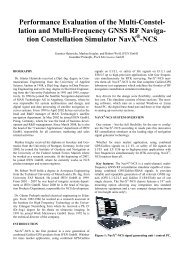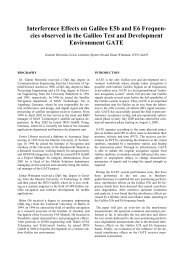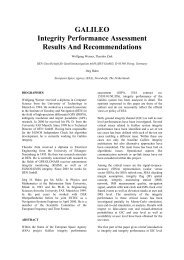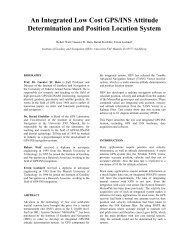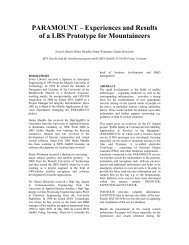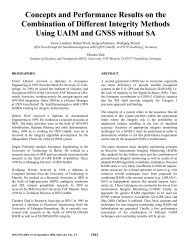Full Paper - IFEN
Full Paper - IFEN
Full Paper - IFEN
- TAGS
- paper
- ifen
- www.ifen.com
You also want an ePaper? Increase the reach of your titles
YUMPU automatically turns print PDFs into web optimized ePapers that Google loves.
• Time Synchronisation Error Statistics at<br />
Sensor Stations<br />
• IF false alarm/ miss detection rate statistics<br />
vs. number of observing sensor stations<br />
• VPL/HPL vs. true error Stanford graphics<br />
obtained with GPS data<br />
• Availability graphics for GPS VPL < 20 m<br />
using high density stations network for<br />
Global coverage<br />
• Availability graphics for GPS VPL < 12 m<br />
using high density stations network for<br />
Global coverage<br />
• Estimated SISE (signal in space error) at<br />
WUL (worst user location) per satellite<br />
• Integrity flag per satellite<br />
• Integrity Check reference data: true SISE<br />
per satellite<br />
• Sigma check per satellite<br />
There are several more core products that may be<br />
generated by use of the E-IPF, but the above listed<br />
products are generated on a day-by-day basis in<br />
routine processing. Long-term products are also<br />
built from some of these to obtain system level<br />
performance results.<br />
Among the additional products that are available in<br />
experimentation are:<br />
• Availability graphics for GPS VPL < 20 m<br />
using high density stations network for<br />
European coverage<br />
• Availability graphics for GPS VPL < 12 m<br />
using high density stations network for<br />
European coverage<br />
• Estimated satellite/plane error per satellite<br />
• Integrity Check reference data: true<br />
satellite error<br />
• Sigma-check maps (quality figure for<br />
accuracy of satellite error estimation)<br />
• Generic time series data and one- or two<br />
dimensional histogram data<br />
For the routine processing a set of baseline<br />
algorithms and their related baseline parameters<br />
have been or are just on the way of being fixed.<br />
Currently the following key algorithms are used for<br />
the baseline integrity processing:<br />
• Raw data validation: The raw pseudorange<br />
is compared to the computed<br />
pseudo-range. The difference between<br />
these two ranges is compared with a<br />
configured threshold.<br />
• Frequency crosscheck: The differences<br />
between the measurements on both L1 and<br />
L2 frequency are compared and checked<br />
via a further configurable threshold.<br />
• Range-variation check: The raw pseudoranges<br />
of the current epoch and of the<br />
previous epochs are compared. If the<br />
variation exceeds a certain limit, the ranges<br />
are discarded.<br />
• Tropospheric model: The tropospheric<br />
model from ESA (ESA, 2003) is used.<br />
Standard values are used to evaluate the<br />
model instead of using real measurements.<br />
However, there is an integrity experiment<br />
foreseen that uses real measurements as an<br />
input.<br />
• Cycle-slip detection: The cycle-slip<br />
detection and repair is based on a<br />
combination of a third order time<br />
difference and a second order polynomial<br />
fit.<br />
• Multipath detection and removal: An<br />
algorithm is used that is based on a set of<br />
digital filter coefficients working on code<br />
minus carrier observables.<br />
• Ionospheric delay correction: No<br />
ionospheric correction is used, because the<br />
dual-frequency iono-free combination is<br />
used as an input to the integrity check<br />
algorithm.<br />
• Sagnac effect: Earth rotation effect during<br />
signal travel time is corrected.<br />
• Solid earth tides: The sensor station<br />
position displacement due to the solid earth<br />
tides is corrected.<br />
• Modified Hatch filter: Code range<br />
measurements are smoothed using carrierphase<br />
measurements and a configurable<br />
smoothing time constant.<br />
• Clock estimation for sensor stations: The<br />
residual measurements are averaged and<br />
outliers are detected and excluded. The<br />
averaged values are band-pass filtered.<br />
• Clock jump / drift detection: The current<br />
measurement is compared against an<br />
expected value, computed with the help of<br />
previous measurements based on an<br />
extrapolated polynomial fit. Clock drifts<br />
are identified by analysing the polynomial<br />
coefficients.<br />
• Satellite and station failures: These types<br />
of failures are identified via majority<br />
crosschecks.<br />
• SISE estimation according to Galileo B2<br />
phase. The worst user SISE is estimated<br />
through an estimation of the satellite<br />
position error (satellite level) based on a<br />
three parameters approach. The estimated<br />
position error is projected to all potential<br />
users in the satellite footprint.<br />
• Integrity check algorithm according to<br />
Galileo B2 phase. This algorithm considers


